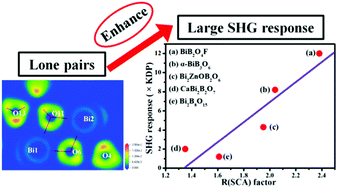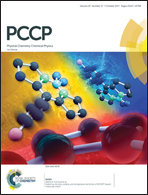The activity of lone pair contributing to SHG response in bismuth borates: a combination investigation from experiment and DFT calculation†
Abstract
Second harmonic generation (SHG) response is one of the most essential properties of nonlinear optical (NLO) materials. To achieve relatively strong SHG response, a feasible strategy is to introduce stereochemically active lone pair (SCALP) cations, such as Bi3+. NLO materials with Bi3+ usually exhibit a huge difference in SHG response, the inner correlation between the activity of SCALP and SHG response still being unclear owing to the lack of quantization estimation of the intensity of SCALP. Based on the calculation results of density functional theory (DFT), we develop a theoretical method to compute the intensity of the Bi-6s SCALP, which could describe the stereochemical behavior and exert significantly influences on some apparent optical properties, such as SHG response. Using the method, we further analyze a series of bismuth borates which exhibit an apparent hierarchy in SHG response: BiB2O4F (12 × KDP), α-BiB3O6 (8.2 × KDP), Bi2ZnOB2O6 (4 × KDP), CaBi2B2O7 (2 × KDP), and Bi2B8O15 (1.2 × KDP). Combining the experimental measurements for the SHG responses, electronic structure analysis and the real-space atom cutting method, we explore the mechanism of the hierarchy in SHG response.



 Please wait while we load your content...
Please wait while we load your content...